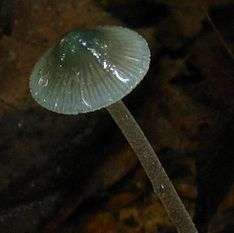Mycena subcaerulea
Mycena subcaerulea is a species of mushroom-forming fungus in the family Mycenaceae. It produces small, thin-fleshed fruitbodies with pale bluish-green caps upon slender stipes. The centers of the caps are darker in colour than the margins, and the cap cuticle can be peeled off. The fungus was first described in 1873 as Agaricus subcaeruleus by American mycologist Charles Horton Peck. His original collections, found growing on the trunks of decaying beech trees, were made in woods of the Adirondack Mountains in Upstate New York.[2] Pier Andrea Saccardo transferred the species to the genus Mycena in 1887.[3]
| Mycena subcaerulea | |
|---|---|
 | |
| Scientific classification | |
| Kingdom: | |
| Division: | |
| Class: | |
| Order: | |
| Family: | |
| Genus: | |
| Species: | M. subcaerulea |
| Binomial name | |
| Mycena subcaerulea | |
| Synonyms[1] | |
| |
References
- "GSD Species Synonymy: Mycena subcaerulea (Peck) Sacc". Species Fungorum. CAB International. Retrieved 2015-05-28.
- Peck CH. (1873). "Descriptions of new species of fungi". Bulletin of the Buffalo Society of Natural Sciences. 1: 41–72 (see p. 47).
- Saccardo PA. (1887). "Sylloge Hymenomycetum, Vol. I. Agaricineae" (in Latin). 5: 263. Cite journal requires
|journal=(help)
This article is issued from Wikipedia. The text is licensed under Creative Commons - Attribution - Sharealike. Additional terms may apply for the media files.